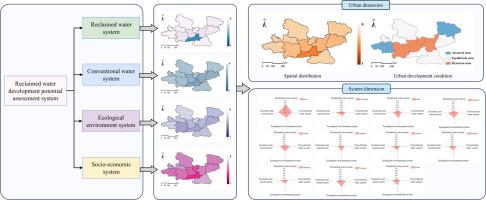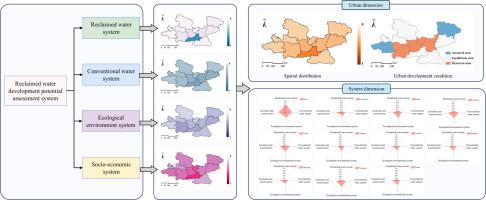城市群再生水开发能力评价——基于模糊n元高度指数的方法
IF 12.4
1区 环境科学与生态学
Q1 ENGINEERING, ENVIRONMENTAL
引用次数: 0
摘要
面对水资源需求增加和污染加剧等全球性挑战,提高再生水利用水平是缓解城市群水资源压力的关键。本研究构建了基于“中水、常规水、生态环境、社会经济系统”四维耦合的模糊评价体系,对中水开发能力进行评价。通过引入左右可拓域构造模糊n元高度指标,对各城市的容量进行量化和比较。建立了城市条件判别函数,分析了实际利用率与目标之间的偏差,提出了针对性的改进措施。以关中平原城市群为例,西安的发展能力最高(0.5491),商洛最低(0.2309)。天水、临汾处于超前状态,宝鸡、咸阳、渭南、铜川处于滞后状态,其他城市处于平衡状态。该研究为城市群协调发展、缓解供需失衡提供了参考。本文章由计算机程序翻译,如有差异,请以英文原文为准。


Assessment of reclaimed water development capacity in urban agglomerations: A method based on the fuzzy n-cell height index
In the face of global challenges such as increasing water resource demand and pollution, enhancing reclaimed water utilization is key to alleviating water pressure in urban agglomerations. This study constructs a fuzzy evaluation system based on the four-dimensional coupling of “reclaimed water, conventional water, ecological environment, and socio-economic systems” to assess reclaimed water development capacity. By introducing left and right extension domains to construct a fuzzy n-cell height index, the capacity of each city is quantified and compared. A city condition discriminant function is also developed to analyze deviations between actual utilization and targets and propose tailored improvement measures. Taking the Guanzhong Plain urban agglomeration in China as a case study, Xi'an has the highest development capacity (0.5491), while Shangluo has the lowest (0.2309). Tianshui and Linfen are in an advanced condition, Baoji, Xianyang, Weinan, and Tongchuan are in a hysteresis condition, and other cities show equilibrium. This study provides references for coordinating development and alleviating supply-demand imbalances in urban agglomerations.
求助全文
通过发布文献求助,成功后即可免费获取论文全文。
去求助
来源期刊

Water Research
环境科学-工程:环境
CiteScore
20.80
自引率
9.40%
发文量
1307
审稿时长
38 days
期刊介绍:
Water Research, along with its open access companion journal Water Research X, serves as a platform for publishing original research papers covering various aspects of the science and technology related to the anthropogenic water cycle, water quality, and its management worldwide. The audience targeted by the journal comprises biologists, chemical engineers, chemists, civil engineers, environmental engineers, limnologists, and microbiologists. The scope of the journal include:
•Treatment processes for water and wastewaters (municipal, agricultural, industrial, and on-site treatment), including resource recovery and residuals management;
•Urban hydrology including sewer systems, stormwater management, and green infrastructure;
•Drinking water treatment and distribution;
•Potable and non-potable water reuse;
•Sanitation, public health, and risk assessment;
•Anaerobic digestion, solid and hazardous waste management, including source characterization and the effects and control of leachates and gaseous emissions;
•Contaminants (chemical, microbial, anthropogenic particles such as nanoparticles or microplastics) and related water quality sensing, monitoring, fate, and assessment;
•Anthropogenic impacts on inland, tidal, coastal and urban waters, focusing on surface and ground waters, and point and non-point sources of pollution;
•Environmental restoration, linked to surface water, groundwater and groundwater remediation;
•Analysis of the interfaces between sediments and water, and between water and atmosphere, focusing specifically on anthropogenic impacts;
•Mathematical modelling, systems analysis, machine learning, and beneficial use of big data related to the anthropogenic water cycle;
•Socio-economic, policy, and regulations studies.
 求助内容:
求助内容: 应助结果提醒方式:
应助结果提醒方式:


